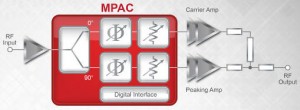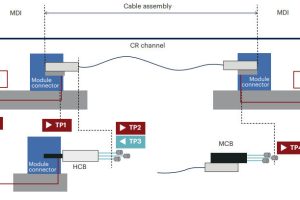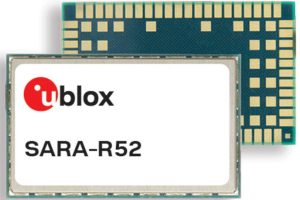
Doherty amplifiers have two RF amplifiers in parallel (see diagram), one Class-AB for low-level signals and one Class-C for peaks. They save power over single amplifiers that can handle high peak-to-average signals, like those of LTE (8dB) and LTE-Advanced, with sufficient linearity.
Signals going into the two amplifiers have to be adjusted carefully to ensure their outputs combine to create the correct antenna feed.
The firm is aiming its chip at macro and small cell base stations.
“The current solution employs discrete components to tune phase and amplitude for carrier and peaking paths,” said Peregrine, which concedes Freescale is also aiming to replace discretes, this time with a system-in-package containing three GaAs and one CMOS die.
Made on a 0.35µm silicon-on-sapphire process, Peregrine’s PE46120 monolithic phase and amplitude controller (MPAC) includes: a 90°hybrid splitter, two phase shifters, two amplitude controllers, and an SPI digital interface.
Both paths can be optimised on-the-fly through the SPI interface to compensate for operational or environmental changes. Switching time is 840ns.
The firm has based the design on existing products, using switches and passive components on-die. Phase shifting is through combined low-pass and high-pass filters. “It is more of an RFIC approach, said Mark Moffat, MD Peregrine UK. “For an X band product [which is mooted], we would probably use more of a MMIC approach.”
Insertion loss is 6.5dB including the 3dB splitter, and operation is from 1.8 to 2.2GHz in 5.6° steps across an 84.4° range, as well as 0.5dB steps across 7.5dB range. Linearity is 65dBm IIP3, return loss 20dB, isolation 28dB, and maximum power 29dBm.
The chip will run off 2.7-5.5V (at 300µA), and over -40 to 105°C.
It comes in a 6x6mm 32 lead QFN, and needs no external dc blocking capacitors.
Other applications proposed are: micro and pico cells (10W and above), electronically-steered radar, and synthetic aperture radar.
Three other versions are in the pipeline: 2.4-2.8GHz, 700MHz-1GHz, and one for LTA-A bands.
At the same time as announcing the intention to introduce the Doherty chip, Peregrine also revealed what it claims are the first monolithic 50W power limiters.
Power handling is +47dBm (50W) pulsed, +40dBm (10W) CW.
PE45140 (20MHz-2GHz) and PE45450 (9kHz-6GHz) are intended as an alternative to discrete GaAs PIN-diode limiters in ‘land mobile radio’ (LMR), test-and-measurement, wireless-infrastructure and radar.
Linearity (IIP3) is over 40dB and limiting threshold can be as low as 22dBm and as high as 35dBm.
Response-and-recovery is under 1ns.
There are two modes: power limiting and power reflecting, with threshold selectable through an analogue control pin voltage.
For example, in limiting mode (Vcontrol = -2.5 to -0.5V) PE45140 performs as a linear power limiter with adjustable P1dB / limiting threshold.
Power reflecting mode requires an external power detector to sample the RF input power and a microcontroller to toggle the limiter control voltage between +2.5V and -2.5V. At +2.5V, limiter impedance to ground is less than 1Ω and most incident power will be reflected back to the source. At -2.5V, the device operates as in power limiting mode.
Package is 3x3mm 12 lead QFN
 Electronics Weekly Electronics Design & Components Tech News
Electronics Weekly Electronics Design & Components Tech News


